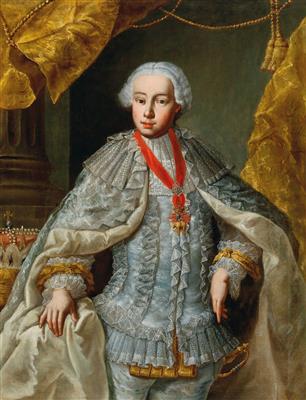Habsburg Court Painter, circa 1765

Portrait of Archduke Leopold (later Emperor Leopold II) dressed in wedding clothes, wearing the order of the Golden Fleece, the archducal crown in the background, oil on canvas, 125 x 96.5 cm, framed
The present painting relates to another, less spontaneously executed, version which is part of a series of four portraits which include the Emperor Franz Stephan, the Empress Maria Theresia and the young archducal couple. This series was commissioned by the magistrate of the city of Bozen to commemorate the wedding of Archduke Leopold (1747–1792) and the Infanta Maria Luisa of Spain (1745–1792), which took place in Innsbruck on the 5th August 1765. Leopold and Maria Luisa had first met in Bozen. The painting in the Bozen series appears to have been inspired by the present portrait, which may commemorate the wedding. It was an important event in the history of the Habsburg dynasty and the court and large numbers of European nobility gathered in Innsbruck. The festivities lasted for over twelve days, but were cut short by the sudden death of the Emperor.The present portrait is painted in a very spontaneous style, especially in the draperies demonstrating the hand of a confident, accomplished artist. Many of the leading court artists must have been present in Innsbruck, and it is entirely plausible that Leopold sat during this time for the present portrait. At present, however, it has not been possible to firmly identify the artist and tentative attributions to Johann Carl Auerbach, Martin van Meytens, as well as Frans Anton Palko have been suggested.
Leopold II is considered one of the most capable of the 18th-century reformist rulers known as the ‘enlightened despots’. He succeeded his father as Grand Duke of Tuscany when his eldest brother became emperor as Joseph II in 1765. During his 25 year reign over the Grand Duchy of Tuscany, he rationalized his states’ taxation and tariff systems and encouraged the development of representative institutions. On the 30th November 1786 Leopold formally abolished the death sentence as well as banning the use of torture, making Tuscany the only modern state with such a liberal penal system. He became emperor upon the death of his brother Joseph in 1790.
We are grateful to Georg Lechner for his help in cataloguing the present painting.
Esperto: Dr. Alexander Strasoldo
 Dr. Alexander Strasoldo
Dr. Alexander Strasoldo
+43 1 515 60 403
oldmasters@dorotheum.com
30.04.2019 - 17:00
- Prezzo realizzato: **
-
EUR 22.130,-
- Stima:
-
EUR 15.000,- a EUR 20.000,-
Habsburg Court Painter, circa 1765
Portrait of Archduke Leopold (later Emperor Leopold II) dressed in wedding clothes, wearing the order of the Golden Fleece, the archducal crown in the background, oil on canvas, 125 x 96.5 cm, framed
The present painting relates to another, less spontaneously executed, version which is part of a series of four portraits which include the Emperor Franz Stephan, the Empress Maria Theresia and the young archducal couple. This series was commissioned by the magistrate of the city of Bozen to commemorate the wedding of Archduke Leopold (1747–1792) and the Infanta Maria Luisa of Spain (1745–1792), which took place in Innsbruck on the 5th August 1765. Leopold and Maria Luisa had first met in Bozen. The painting in the Bozen series appears to have been inspired by the present portrait, which may commemorate the wedding. It was an important event in the history of the Habsburg dynasty and the court and large numbers of European nobility gathered in Innsbruck. The festivities lasted for over twelve days, but were cut short by the sudden death of the Emperor.The present portrait is painted in a very spontaneous style, especially in the draperies demonstrating the hand of a confident, accomplished artist. Many of the leading court artists must have been present in Innsbruck, and it is entirely plausible that Leopold sat during this time for the present portrait. At present, however, it has not been possible to firmly identify the artist and tentative attributions to Johann Carl Auerbach, Martin van Meytens, as well as Frans Anton Palko have been suggested.
Leopold II is considered one of the most capable of the 18th-century reformist rulers known as the ‘enlightened despots’. He succeeded his father as Grand Duke of Tuscany when his eldest brother became emperor as Joseph II in 1765. During his 25 year reign over the Grand Duchy of Tuscany, he rationalized his states’ taxation and tariff systems and encouraged the development of representative institutions. On the 30th November 1786 Leopold formally abolished the death sentence as well as banning the use of torture, making Tuscany the only modern state with such a liberal penal system. He became emperor upon the death of his brother Joseph in 1790.
We are grateful to Georg Lechner for his help in cataloguing the present painting.
Esperto: Dr. Alexander Strasoldo
 Dr. Alexander Strasoldo
Dr. Alexander Strasoldo
+43 1 515 60 403
oldmasters@dorotheum.com
|
Hotline dell'acquirente
lun-ven: 10.00 - 17.00
old.masters@dorotheum.at +43 1 515 60 403 |
| Asta: | Dipinti antichi |
| Tipo d'asta: | Asta in sala |
| Data: | 30.04.2019 - 17:00 |
| Luogo dell'asta: | Wien | Palais Dorotheum |
| Esposizione: | 20.04. - 30.04.2019 |
** Prezzo d'acquisto comprensivo di tassa di vendita e IVA(Paese di consegna Austria)
Non è più possibile effettuare un ordine di acquisto su Internet. L'asta è in preparazione o è già stata eseguita.
